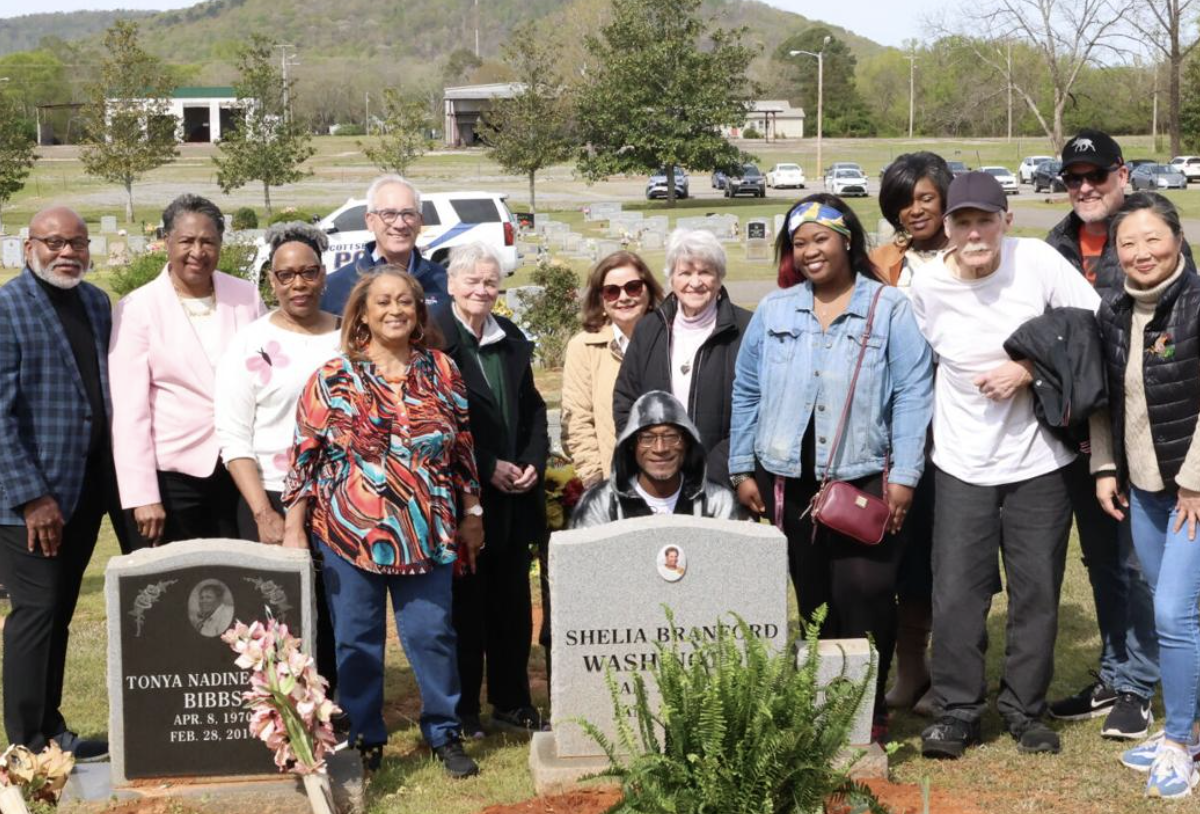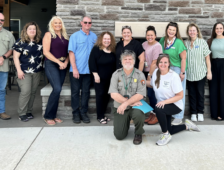Museum commemorates 93rd anniversary of the Scottsboro Boys Trials
By Danielle W. Kirkland
The 93rd Anniversary of the Scottsboro Boys Trials kicked off with a walk to the gravesite of Scottsboro Boys Museum founder Shelia Washington on the morning of April 6.
Ninety-three years ago Haywood Patterson, Olen Montgomery, Clarence Norris, Willie Roberson, Andy Wright, Ozzie Powell, Eugene Williams, Charley Weems and Roy Wright were pulled from a Southern Railroad freight train in Paint Rock, Alabama. They were unjustly accused of assaulting white men, and accusations of raping two white women who had been aboard the train soon followed.
On Saturday, April 6, the Scottsboro Boys Museum commemorated the beginning of the trial of the Scottsboro Boys, which began on April 6 in 1931.
The event began with a walk from the Scottsboro Boys Museum to Shelia Washington’s gravesite at Cedar Hill Cemetery. Washington, who founded the museum and helped lead the way for the posthumous exoneration of the nine men by the Alabama governor, passed away in 2021.
As he walked down Willow Street, toward the cemetery, John Pepper said he joined in the walk that morning because he believed in Washington’s cause.
Pepper said he heard of the Scottsboro Boys when he moved to the town at 16 years old. He didn’t know much though until years later when he read about the trial in The Jackson County Historical Association’s Chronicles.
Last week, at the age of 81, Pepper visited the museum for the first time.
“It was a great injustice,” Pepper said. “That was 1931 deep down in the south, and it was a terrible, terrible thing. The trial here in Scottsboro was a miscarriage of justice. In Decatur they began to sort it out, but it’s still a terrible thing that happened to young boys. Their lives after that were completely changed, if not destroyed.”
At the gravesite, Thomas Reidy, executive director of the museum, spoke about Washington.
“I met Shelia when I was 50 years old. It was 14 years ago,” Reidy recalled. “ She had become, in a very short time, one of my dearest friends, and more than that, a confidant. I miss her dearly.”
Reidy said Washington had a big part in the recent renovations of the museum.
“Everything you see in the museum now, she was a part of that creation,” Reidy said. “She just didn’t get to see it fabricated and put up on the wall. But, she saw it on the computer screen, and she knew we were going to do it. I think she is looking down today to make sure that we keep working.”
David Poe, Washington’s best friend, explained to the group how he had moved flowers from Washington’s yard to her gravesite. He recalled how Washington, a distant cousin, had approached him in line at Burger King when he was 16 years old.
“I’m trying to organize a youth group, and I need your help,” Poe said Washington told him.
Poe said he and Washington worked together to organize a youth group for African Americans.
“Shelia was always trying to get something done for the youth, and always trying to open doors and avenues for prosperity and growth in Scottsboro,” Poe said, adding that the organization was then known as the Ben Sanford Youth Center, and is now known as the Boys and Girls Club.
Walking back to the museum, Peggy Parks Miller, who travelled to Scottsboro from Georgia, recalled learning about the trial of the Scottsboro Boys through a search for family history.
“I’m the neice of Clarence Norris,” Miller explained.
Miller said twenty years ago she began looking at her family history and found a book that Norris had written.
“I became totally infatuated with the case,” Miller said.
Miller said the case was not something her family talked about, other than in hushed voices.
“Maybe it was because the communication was such that they didn’t actually know what was going on, but you’re talking about the 30s and 40s when there was still alot of fear about legality, when you’re talking about raping a white woman, that was not something that was going to be broadcast in a black family,” Miller said. “I did the research and looked into it and worked on making my family aware of what happened to Clarence.”
For Miller, it was fascinating to learn how the mothers of the young men had banded together, even traveling to Europe to educate people and raise money for help.
“This is the first time a group of black women were able to get together and fight for justice for their sons,” Miller said.
Miller said it gives her pride to know that more than 90 years later, her family member and the others have been vindicated.
“That doesn’t happen in the black community much,” Miller said.
Looking into the distance at a row of trees growing along a roadside, Miller pondered what could have happened if the lynch mob had gotten their way all those years ago.
“Those nine boys, can you imagine?” she asked. “ These were kids. I’ve got grandkids their ages, 13 and 19. It’s just by the grace of God they weren’t hung.”
But, Miller said now her ancestors can rest in peace knowing they have been exonerated.
“It’s such a pivotal situation, the first time that black men were shown a little bit of justice from the legal system,” Miller said. “Had it not been for Sheriff Matt Wann, who would not give the boys to the mob, they would have been hung. Sometimes, it’s just key people in key places that can really change the scope of things.”
When the walk ended, the museum filled with people there to participate in the commemoration program.
The program began with a speech given by Shilo Fonji. Fonji, a fifth grader from Huntsville who recently won first place in the Optimist Club’s oratorical contest, spoke about how to change the world with optimism.
“My parents often remind me that the world cannot be changed from a pessimistic outlook on life,” Fonji said. “We can never accomplish change by saying I can’t. Fortunately, in our home, old man can’t died a long time ago.”
Next, Judge John Graham spoke.
“(The Scottsboro Boys Trial) was a terrible thing, but I believe out of most tragedy can come good things,” Graham said.
Graham said Scottsboro is known for the Scottsboro Boys trial and Unclaimed Baggage
“I have had that reaction everywhere from Huntsville, Alabama, to Shanghai China and everywhere in between,” Graham said.
Graham explained that for a long time, local citizens wanted to forget about the Scottsboro Boys and hoped the history would go away.
“I thought what we need to do is embrace it, uphold it and learn from it,” Graham said. “… I mean no-disrespect, but for a lot of people locally, the Scottsboro Boys is a form of unclaimed baggage, and we need to claim that bagage, and own it and deal with it and get on our big boy and big girl britches and deal with our heritage … It is for us, the modern generation, to do the right thing.”
Next, Reidy spoke, and explained that Scottsboro became a metaphor for the Jim Crow South. Reidy read the poem “Scottsboro” by Langston Hughes, and explained that through the poem, Hughes uses Scottsboro to talk about Jim Crow, as well as the town itself.
“So the question becomes, how can this museum, how can the leaders in this community, how can we better come to grips with this past,” Reidy said, adding later that he suggests learning the story, embracing the story together and commemorating it so we can move forward and learn lessons from the Scottsboro case.”
Judge Herman “Rusty” Johnson was the last speaker at the event. He spoke about the role of honor in abolishing the spirit of slavery and asked what motivated Sheriff Matt Wann in 1931.
“At dusk a mob had gathered at the county jail in Scottsboro with the intent to lynch all of the young men,” Johnson said. “As we know, at that moment in the United States we had a long history of lynchings against black people accused of criminal activity, particularly allegations of rape of a white woman. In the large majority of lynchings, law enforcement personnel facilitated the executions, or at best stepped aside and allowed mobs to satisfy their lust for violence.”
Johnson explained that Wann had been different, as he barricaded the jail house and warned the mob outside that his men would shoot to kill if the crown stormed the jail.
“Was it merely a commitment to duty that spurred Sheriff Wann’s actions, or was it also a sense of honor and adherence to standards and conditions that the law should take its due course?” Johnson asked.





